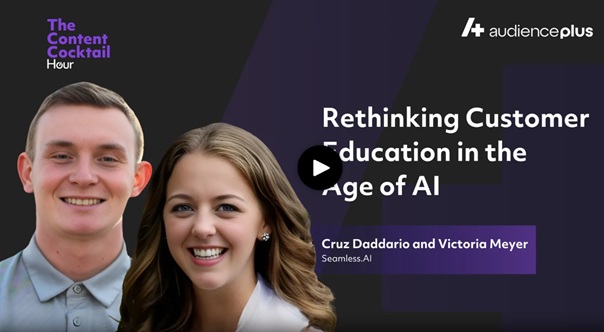“Just do it.”
There’s not a single soul in modern society that doesn’t know which marketing campaign this tagline comes from: Nike’s iconic marketing campaign from almost over 30 years ago that still reigns supreme to this day.
Nike didn’t just make history with a simple catchphrase, they completely rewired our brain chemistry to make us subconsciously associate that tagline with the brand for an entire generation.
Not only that, but Nike’s genius and legendary marketing catchphrase also serves as a prime example of how to do prospecting in marketing–the right way.
Nike didn’t just use a list of contacts to find new prospects or marketing qualified leads. They used the catchphrase “Just do it” almost as an elevator pitch of what they represented as a brand and a hook to get new prospects to relate to them on a more personal level.
This brilliant marketing ploy is more than just a catchphrase, it's a case study of how you can use prospecting data to inform your marketing campaigns to resonate deeply, attract more high-value MQLs, and build more brand affinity,
Want to learn more about prospecting in marketing? This article is for you.
📕 Psst…Ready to dive into prospecting for marketing? Explore our comprehensive directory of the top marketing companies in the U.S., with all the contact information you need to start building your prospecting lists.
Here, you’ll find the full rundown on marketing to prospects:
- Definition of prospecting in marketing
- The difference between prospecting vs marketing
- Why marketers should care about prospecting
- Real-life examples of marketing done right with prospect data
- Tips for generating more MQLs with prospecting tools
What is prospecting in marketing?
Prospecting in marketing is all about generating MQLs, or marketing qualified leads, to eventually convert to become an SQL, or a sales qualified lead, and enter the sales funnel.
In other words, looking for prospects as a marketer is all about finding people who fit your ideal customer profile with the goal of converting them into a customer.
Prospecting is a term usually used in the sales department, but marketers can still take advantage of B2B prospect data to understand what kind of people are engaging with the company’s brand.
Finding your dream customers in marketing is like unlocking new characters in a game to explore new levels and opportunities for growth.
Related: What is Sales Prospecting?
Prospecting vs marketing
You can do prospecting as a marketer, but prospecting isn’t necessarily just a “marketing thing”. Technically, anyone can do prospecting to find the right people for their needs.
The difference between prospecting and marketing is that prospecting is a strategy used in marketing to find a larger audience and help the sales team reach their full TAM potential. Let’s break down the two into their basic definitions to get a better idea of how prospecting fits into the marketing world.
Marketing is any action a company takes to attract an audience to their product or service through high-quality messaging.
Prospecting is the act of searching or looking for something or someone. In the B2B world, prospecting is the process of identifying and contacting potential customers.
Marketers can both prospect and attract customers. Their job is to attract as many people as possible. Doing outbound marketing through prospecting is one way that marketing teams find the right audience.
A great example of using brilliant marketing tactics to attract the shiny new audience that your brand is set on targeting is Apple. We can’t talk about iconic marketing campaigns for prospecting without mentioning the absolute cultural reset that Apple has had on our lives for generations now.
Think back to when the first versions of the iPhone came out. There were masses of people standing in miles-long lines overnight, rain or shine, to be the first to get their hands on the newest iPhone.
If there’s one thing that Apple’s great at doing, it’s making people feel FOMO and want to belong to a community, regardless of what they need to do to make that happen.
Almost everything Apple puts out there, it succeeds. It’s almost to the point of annoyance–like how do they do this every time? It’s because there’s a science to their prospecting and marketing strategy that’s evolved over the years.
Their marketing strategy takes multiple approaches, but the main premise of their marketing is to turn casual buyers into brand ambassadors. This fuels their prospecting approach to seek out consumers who are willing to pay top dollar for sleek design, seamless user experience, and prestige.
Apple is a prime example of how a brand should be using their marketing to fuel their prospecting efforts. We’ll explain more below about why you need prospecting in marketing, and vice versa.
Related: Guide for B2B Marketing
The power of prospecting and marketing together
Marketers are not the only ones responsible for finding prospects at an organization, but it’s a crucial point that both sales and marketing teams should align on.
When you align both your prospecting and marketing strategies, the workflow between the two becomes less siloed and more synchronized, like a harmonious transition between the hook or intro of a new hit song and the moment the beat drops for the chorus.
Prospecting provides the roadmap and coal necessary to ignite the sparks of marketing campaigns. Prospecting informs your marketing approach–the same way that Apple or Nike understood their prospects on a deeper level to come up with their iconic marketing strategies and campaigns.
Here are a four reasons why marketers should create marketing campaigns informed by prospecting:
1. Helps you identify your target audience.
As a marketer, your job is to send the right message, to the right people, at the right time. The first step is figuring out who the right people are.
Imagine you’re a marketer for a company that sells IT software to healthcare companies. You probably don’t want to waste your precious time getting brand exposure to an audience that is irrelevant to the healthcare industry.
Through segmentation, marketers can use prospecting tools to segment large datasets into specific categories based on demographics, behaviors, and interests. If you’re prospecting for an audience in the healthcare industry, you can narrow down your target audience based on those different categories and tailor your marketing messaging to cater to each category.
The best part about prospecting in marketing is that you can use tools to also find new prospects that are similar to your existing customers, AKA your “lookalike audiences”. The more similar they are to your current audience, the more likely they will convert.
In a broader sense, the more you know your prospects, the more personalized you can make your
2. Data collection and analysis.
You may think you know your audience, but think again. How well do you really know your prospects enough to create the next big hit marketing campaign?
It’s almost impossible to keep track of all the characteristics of your target prospects in marketing without having some sort of data collection and analysis system.
You can use lead database tools or lead search engine tools like Seamless.AI or LinkedIn Sales Navigator to find new prospects while keeping track of:
- How much TAM you’ve achieved
- The contact details for each one
- Important details about their industry and other firmographic data
- Behavioral insights from their social media and online behaviors
Beyond this, simply knowing your prospects to a “T” is prospecting 101. Knowing the world in which your prospects operate is so crucial to craft messages that resonate deeply.
3. Refined messaging and outreach
Prospecting helps marketers finetune their messaging and outreach to resonate deeply with the right people. After all, the content of your marketing messaging and product positioning should be based on who you’re talking to.
Take Duolingo, for example. Duolingo is a great example of a brand that’s mastered the art of finetuning their messaging to target a younger audience on TikTok through the use of “brain rot” memes (IYKYK, but if you don’t–we explain more about the new wave of nonsensical lingo among today’s youth here).
While Duolingo’s current user base is diverse across age and demographics, they’ve been going all-in on prospects who skew younger. It makes sense given the gamification style of Duolingo’s language learning app. The point is, the real-time feedback and engagement with prospects on TikTok enables Duolingo to tailor their messaging and outreach accordingly.
You can use email outreach tools like Hubspot, Mailchimp, or Outreach to automate your personalized email marketing campaigns at scale is one way to maximize your reach. If you want to go all-in on your social media marketing like Duolingo, you can use social media management tools like Hootsuite or Sprout Social to schedule and manage your posts to engage with prospects where they spend their time most online.
Related: Generate More Leads & Sales with TikTok
4. Scoring and prioritization
As a marketer, your job is to understand where your prospects are in the customer buyer journey. Are they TOFU or BOFU? No, we’re not talking about being vegan-friendly with white cubes of tofu; we’re talking about your prospects being top of funnel (TOFU), middle of the funnel (MOFU), or bottom of the funnel (BOFU).
These few acronyms are key to helping you tailor your messaging to meet your prospects where they are.
Let’s say you’re overwhelmed with the amount of new prospects you have from a few viral marketing ploys on social media (what a dream problem to have, right?). Which prospects from your audience are you going to prioritize for your outreach and further targeting?
That’s where lead scoring comes in. Prospecting helps set the base knowledge you need to start choosing the marketing lead profiles that are most likely to convert or become a customer.
Lead scoring with the help of prospecting tools assigns scores to leads based on their likelihood to convert. The higher the score, the more you can prioritize your marketing efforts on high-value prospects.
Related: How to Score your Fresh New Leads
Another advantage of using prospecting tools to inform your marketing strategies is being able to integrate your prospects’ data with your CRM. You might have heard of or used CRM tools like Salesforce or HubSpot for your marketing campaigns. Integrating your marketing prospect data with these tools helps keep your lead data in a single source of truth–making the data centralized, accessible, and manageable.
The bottom line here is to keep track of your high-value marketing leads with prospecting tools that integrate seamlessly with your CRM.
Ideal Prospecting Marketing Strategies
There’s no one-size-fits-all approach to marketing to your prospects.
In reality, you need to craft a multi-channel approach to target these potential customers–a mix of social, email, blog content, events, and more.
While there are certain industries that may do well on certain platforms over others, the beauty of the marketing world is that you can test and try what works best for your audience.
Here are a few prospecting strategies that marketing teams should focus on to maximize their reach:
- Build a massive social presence
- Segmenting email campaigns
- Personalization in prospecting marketing with generational selling
Building a massive social presence
Think of your social media profiles as the gateway to your brand.
We now live in an almost Black Mirror-esque society where your social media profile is your entire reputation. Aside from the negative effects social media might have on our society as a whole, let’s focus on how to use your social media presence to your advantage for your marketing strategies.
Businesses that are killing it in the social media world with witty and timely marketing campaigns are bound to find the most prospects and engagement.
Case in point: If you haven’t checked out Red Bulls social media profiles yet, you’re missing out. From jaw-dropping extreme sport stunts like jumping out of a helicopter to land on a snowy terrain in a place you’ve probably never heard of before, or showcasing the ins and outs of F1 Grand Prix races, you’re in for a real thrill.
More importantly, Red Bull is a master at crafting their identity engrained in extreme sports and adrenaline-inducing stunts to embody their iconic tagline, “Red Bull gives you wings.” Their strategic use of storytelling, shock-factors, and awe-inspiring posts undoubtedly reels in more prospects who want to be a part of that lifestyle.
Their secret weapon in social media is their ability to showcase the experiences that their prospects could be living by being affiliated with the brand. Drink Red Bull, and you’re a part of a community of some of the greatest athletes in the world.
Be like Red Bull. Leverage your social media profiles to create a presence that can’t be ignored.
Create an experience or craft a story through your social media marketing to attract new marketing prospects like moths to a light.
You can choose from multiple platforms like LinkedIn, Twitter, and Instagram to showcase your expertise, share valuable content, and engage with your audience. Keep in mind, however, that you need to understand how each social media platform works and how your target audience is interacting on each platform to really grab the spotlight.
Related: How to Build a Massive Social Presence
Segmenting email campaigns
Email marketing isn’t just about blasting generic messages to your entire list. It’s also not about promoting your brand over and over again.
Here’s what email marketing is: Delivering value to your audience who wants to know more about what you have to offer.
Prospecting is great for email marketing because you can tweak your email campaigns and messaging based on different segments of your audience.
Your prospects’ data should help inform how you should structure the different segments of your target prospects. Maybe one segment of your audience is just getting to know your brand and they’re not ready to buy-in. You can send more information, educational, and entertaining email campaigns to this segment.
Another audience segment might be your existing customers who are already familiar with your brand. You can send more product-focused email campaigns or customer education style emails to this segment.
You want to make sure that your email campaigns are not bombarding your audience segments with useless information. After all, your goal is to shine through overcrowded email inboxes.
Our suggestion? Explore email marketing tools like Mailchimp and ActiveCampaign to segment your audience based on behavior, preferences, and demographics. This ensures your messages are relevant and personalized, increasing the likelihood of engagement and conversions.
Related: Guide to sending bulk emails for marketing
Marketing across generations of prospects
We can’t stress this one enough: Know who you’re talking to.
That means knowing how to adjust your marketing messaging and lingo to include the same vernacular or concepts that are relevant to your dream customers, especially across different age groups.
Millennials might respond well to digital content and social proof, while Baby Boomers might appreciate more direct and traditional forms of communication. There’s no hard or fast rule on how to market to Gen Z vs. Millennials vs. Boomers, but prospecting tools help you keep a pulse on the signals or patterns of behavior in your prospects that can help inform your messaging strategy.
For example, you can use a prospecting tool like Seamless.AI to keep track of intent signals, or behavioral patterns of your prospects that paint a picture of their likelihood to convert or engage with your brand.
This might mean keeping an eye out for breaking news in your industry that might affect a segment of your target market, like mass layoffs or a spike in the use of AI. You want to keep these events in mind when crafting marketing messages to your prospects, on top of tweaking your marketing messaging to resonate with the age group you’re dealing with.
You don’t need to start ramping up your meme game or “brain rot” humor to resonate with your younger audiences (although it definitely helps sometimes). The point is to understand how certain things affect different segments of your market and predicting how different generations will react or behave based on certain signals.
Related: How to leverage generation selling for your marketing
Examples of successful marketing powered by prospect data
We’ve covered a few examples of brands that are crushing it in the marketing world to attract boatloads of new prospects, but here’s a couple that are more relevant to the B2B industry: HubSpot’s Inbound Marketing and Salesforce.
If you haven’t heard of HubSpot by now, are you really in marketing? Jokes aside, HubSpot is a leading inbound marketing and sales platform that provides tools to prospect and engage potential customers. They provide prospecting tools for other companies while using their own tools to do the same.
Here’s what’s so great about HubSpot: For any marketing campaign, you can use their software to track website visitors, capture leads through buildable forms or landing pages, and even score your MQL’s based on their engagement with your content. Building marketing campaigns while prospecting is easy breezy with this tool.
This inbound approach helps HubSpot attract qualified prospects, nurture them through the buyer’s journey, and ultimately convert them into paying customers.
The same goes for Salesforce, the leading cloud-based CRM software for companies everywhere. It’s used as both a sales and marketing tool, which makes it even more successful by streamlining the process of sales prospecting and building marketing campaigns all in one platform.
Here’s what’s so great about Salesforce for marketers using prospecting data: You can use their Einstein Analytics, a feature that helps marketers leverage AI-driven insights from prospecting data. You’ll find it easy to integrate data from various sources like CRM, social media, email campaigns, or website interactions into a single place to get a high-level view of your prospects’ behavior.
Using AI, Einstein Analytics helps predict which prospects are most likely to convert based on historical data, trends, and patterns that signal this.
Here’s what this looks like in practice.
Imagine you’re a marketer at a B2B software company that uses Einstein Analytics to analyze prospect engagement data from your latest email campaign. The AI-driven insights reveal that a specific segment of prospects, primarily mid-level managers in the tech industry, shows a higher engagement rate with content related to cybersecurity. With this data in mind, you might decide to create a targeted follow-up campaign focused on cybersecurity solutions, personalized for this segment.
From this data-informed approach, you can expect to see higher conversion rates.
With the right prospecting data at your fingertips, you have the power to create marketing campaigns that put you on the right path to getting more brand recognition, higher conversion rates, and stronger brand affinity.
Tips for generating more MQLs with prospecting tools
Want to start generating more high-value MQLs with prospects’ data? The possibilities are endless, but here are a few tips to help you make the most of your data.
- Start leveraging AI Tools: Platforms like Seamless.AI use AI to find and verify contact information, making it easier to reach decision-makers.
- Use CRM Systems: Integrate tools like Salesforce or HubSpot CRM to manage and analyze customer interactions and data throughout the customer lifecycle.
- Optimize Content: Ensure your website and landing pages are optimized for SEO and provide valuable content that addresses your prospects' pain points.
Related: How to Use Seamless.AI for Marketing


















